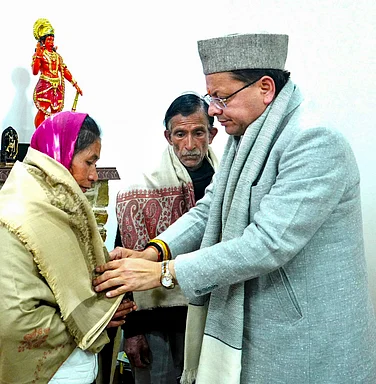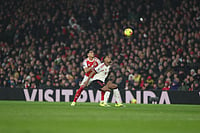A weak government and political turmoil in Pakistan make the Indian army see war clouds on the horizon. With the Nawaz Sharif government riddled with domestic problems, the recently-concluded 10-day military exercise involving the army and the air force in the Rajasthan desert was a message to Pakistan that India is in an offensive rather than a defensive mode. Not only was the exercise massive in its scale, it also demonstrated India's military capability to penetrate deep into enemy territory, carve out a part of it and hold on to it.
Senior army officers believe that this operation, christened Shiv Shakti, and Tri Amph-98, a joint army-navy-air force exercise conducted last month off the Goa coast in which amphibious landings were practiced, should have sent Pakistan clear signals that the Indian forces are all geared to attack. For Pakistan, the obvious meaning of the two exercises is that any attack would be two-pronged—one from the western border, the other through landings on the Pakistan coast.
So extensive was the scale of Shiv Shakti that Pakistan was forced to conduct a similar exercise. On December 7, the last day of Shakti, intelligence reports spoke of Pakistan flexing its muscle. Points out a senior officer: "It was only to be expected. Whenever we carry out an exercise, the Pakistanis have no option but to react."
Billed as the biggest exercise since Operation Brasstacks a decade ago, Shiv Shakti boasted a strength of 60,000 jawans, 4,500 junior commissioned officers and 1,800 officers. As many as 600 tanks, 400 heavy artillery guns—including the Bofors—armoured personnel carriers, radar and communication systems, missile launchers, antiaircraft guns, Jaguars, MiG 27s, and attack helicopters were deployed in the exercise. According to Lt Gen. H.M. Khanna, the GOC-IN-C of the Southern Command: "The exercise assumes additional significance because it offered an opportunity to crank in elements and conduct a decisive offensive operations in the desert."
The exercise also gains significance in the aftermath of the Pokhran tests. Strangely, Shiv Shakti, which was conducted on a 150-km desert stretch in the vicinity of Pokhran, only reaffirmed the fact that a conventional rather than a nuclear war is what the army is geared up for. All senior officers contacted by Outlook spoke of how the nuclear edge could at best act as a deterrent.
In fact the only strategy the exercise incorporated taking into account a nuclear war was ensuring that troop deployment would be spread out and not concentrated. This would cause minimal damage should smaller nuclear warheads with localised effect be used. The developers of this strategy believe that a large bomb of the Hiroshima kind would not be used.
The artillery is already geared for a nuclear war scenario. The T-72 Ajeya tanks are fitted with sensors that detect nuclear radiation as well as dangerous chemicals. The sensors activate a mechanism that seals off the tank even as air filters ensure that the crew gets uncontaminated air. The protective device came with the original Russian design and has not been newly incorporated.
Though every effort was made to create a war-like situation, no guns boomed during the entire Shiv Shakti exercise. Neither were blank rounds fired. The exercise was to see how well men and material could move in a war-like situation. So the officers and men were divided into two groups—the Blue Land and the Red Land groups. The task of the former was to advance into the latter's territory and occupy it.
But the exercise was not just about moving into enemy territory. Points out a colonel in charge of the operation: "In a war, particularly if it is fought in the desert, the key factor is how well you can sustain the advancing force. To keep the force fighting fit it needs replenishments—food, water, fuel and ammunition. If you can't provide these inputs regularly, you can't hold on to your gains."
SO what was put to test in Shiv Shakti was also the ability of the supporting cast to sustain the troops pushing ahead. The engineers therefore were hard pressed to construct a road through the desert to ensure vehicular movement. Using metal sheets that can be unrolled on the ground, they made a road at an astonishing speed of 1 km an hour. In two days they laid 48 kms of road. Similarly helicopters air-dropped supplies in 1.5 tonne packages. Refuelling points were also established.
The focus has been to ensure that the army at the core of the fighting always has supplies and ammunition to last 24 hours. Without this, no push into Pakistan can possibly yield a positive result. "Not only do we have to capture a place but we have to occupy it and the soldiers have to hold on to it till such time that additional troops are sent."
According to army officers, while such movements were deemed practical on paper, they had not been put to test on the ground level and in conditions prevailing in an actual war. "We had to test our capability in the desert because we believe should war break out, the western sector would be very much alive. And it was important for us to understand our strength and our weaknesses," says a senior officer.
Also put to test was the communication equipment. The army has inducted modern communication systems and it was necessary to see how well the equipment worked on the field. According to senior officers, communication plays a very vital role in modern warfare; it can turn defeat into victory. Their new, sophisticated equipment enables the army not only to spy on the enemy but also jam their communication network.
In another first, the Shiv Shakti exercise saw the use of indigenously-developed remote-controlled reconnaissance aircraft that fly into enemy territory and transmit pictures to the base. They help to ascertain tank and troop movements. The army is very pleased with the results of the current testing since it gives it an edge over Pakistan which does not have a similar reconnaissance plane. Also the army would not have to depend solely on satellite pictures to ascertain enemy movements.
Beyond all this, what has made Shiv Shakti a special exercise is that it was a joint operation involving both the air force and the army. While conventional exercises by the army merely presume the presence of air support, the present operation actually pressed into service MiG-27s and Jaguars as well as attack helicopters. It also used transport planes to drop supplies. Tri Amph-98 proved that an amphibious landing of a brigade of commandos with tanks and heavy equipment is possible. Shiv Shakti was proof that the army is capable of managing material and men in a possible war in the desert. The army sees this as a testimony of its capability.
But does the army believe its prowess will be tested in an actual war? Senior army officers point out that they hope Pakistan does not push the country into one. However, given the continuing low-intensity war in Kashmir, they point out that the army must be prepared for the worst. More than anything else Tri Amph-98 and Shiv Shakti reflect the tough posturing of the present government vis-a-vis Pakistan. The army would like it to be known that should war break out, it will not hesitate to attack.






















